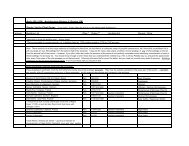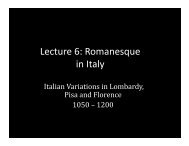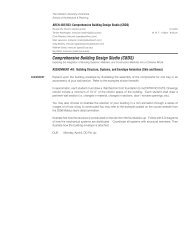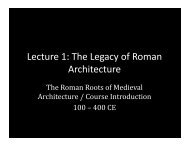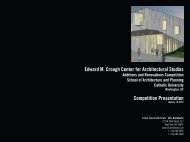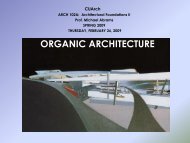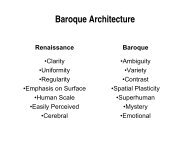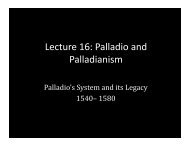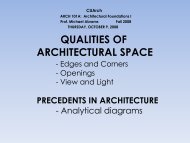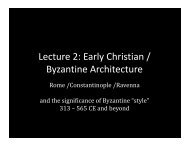Lecture 18: Baroque Rome - School of Architecture and Planning
Lecture 18: Baroque Rome - School of Architecture and Planning
Lecture 18: Baroque Rome - School of Architecture and Planning
Create successful ePaper yourself
Turn your PDF publications into a flip-book with our unique Google optimized e-Paper software.
Will look at: the “laboratory” <strong>of</strong> <strong>Rome</strong>, in the<br />
development <strong>of</strong> the <strong>Baroque</strong><br />
• The idea <strong>of</strong> the “gr<strong>and</strong> manner” – the planning <strong>of</strong> <strong>Rome</strong>,<br />
starting in earnest w/ Pope Sixtus V (served 1585‐1590)<br />
• The variety <strong>of</strong> <strong>Baroque</strong> church architecture in the 17th century <strong>Rome</strong> – the architectural “culture” <strong>of</strong> <strong>Rome</strong> ‐‐<br />
bbuilding ildi on th themes ddeveloped l diin MMaderno’s d ’ SSanta t SSusanna<br />
• The “aedicular façade” ‐‐ aedicule = canopied niche flanked by<br />
columns<br />
• The continuing relevance <strong>of</strong> the model <strong>of</strong> Michelangelo’s<br />
work – such as: 1) the “buried” buried columns in the Laurentian<br />
Library 2) the broken pediments, giant orders in the<br />
buildings <strong>of</strong> the Campidoglio<br />
• The role <strong>of</strong> this architecture in the urban planning schemes<br />
• Finally – a look at Gianlorenzo Bernini, as the first <strong>Baroque</strong><br />
era “genius” (the second, Francesco Borromini to be looked at<br />
in depth on Wed)<br />
• And Bernini’s role in the completion <strong>of</strong> Saint Peters<br />
Two general plan<br />
typologies used – per<br />
NorbergSchulz<br />
Ching p502



